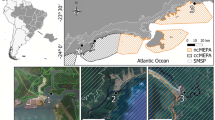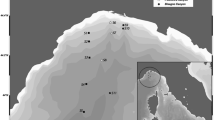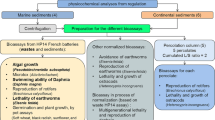Abstract
Purpose
One of the central issues related to global changes in weather is the increasing occurrence of flood events that can result in the re-suspension of contaminated sediments in rivers. Here, we report on a proof-of-concept study combining hydraulic engineering and ecotoxicology in a new interdisciplinary approach to assess the toxicity of re-suspended polluted sediments after a simulated flood event.
Materials and methods
Rainbow trout (Oncorhynchus mykiss) were exposed for 5 days under simulated flood conditions in an annular flume with artificial sediments that were spiked with a mixture of polycyclic aromatic hydrocarbons (PAH) at environmentally relevant concentrations. Specifically, the objective of this study was to bridge the gap between the physical re-suspension of pollutants and resulting toxicological impacts on aquatic organisms. A suite of different molecular, biochemical and histological markers was used to test the hypothesis that re-suspension of sediments can lead to re-mobilization of PAHs and subsequently to effects on aquatic organisms.
Results and discussion
The micronucleus frequency was significantly 4.3-fold elevated after exposure. There was no significant indication of Aryl hydrocarbon receptor signaling (no EROD induction or increased CYP1A protein content, only slight induction of CYP1A gene expression). Biliary metabolite concentration was the most sensitive marker of PAH exposure. Results for other biomarkers (glutathione-S-transferase, catalase and lipid peroxidation) were inconclusive.
Conclusions
In combination with chemical analyses of suspended matter, the presented approach will be used to improve understanding of the re-mobilization of pollutants from sediments in support of environmental risk assessment.






Similar content being viewed by others
References
Ahlf W, Hollert H, Neumann-Hensel H, Ricking M (2002) A guidance for the assessment and evaluation of sediment quality—a German approach based on ecotoxicological and chemical measurements. J Soils Sediments 2:37–42
Alexander M (2000) Aging, bioavailability, and overestimation of risk from environmental pollutants. Environ Sci Technol 34:4259–4265
Aniagu SO, Day N, Chipman JK, Taylor EW, Butler PJ, Winter MJ (2006) Does exhaustive exercise result in oxidative stress and associated DNA damage in the Chub (Leuciscus cephalus)? Environ Mol Mutagen 47:616–623
Arnold H, Pluta HJ, Braunbeck T (1995) Simultaneous exposure of fish to endosulfan and disulfoton in-vivo—ultrastructural, stereological and biochemical reactions in hepatocytes of male rainbow-trout (Oncorhynchus mykiss). Aquat Toxicol 33:17–43
Arnold H, Pluta HJ, Braunbeck T (1996a) Sublethal effects of prolonged exposure to disulfoton in rainbow trout (Oncorhynchus mykiss): cytological alterations in the liver by a potent acetylcholine esterase inhibitor. Ecotoxicol Environ Saf 34:43–55
Arnold H, Pluta HJ, Braunbeck T (1996b) Cytological alterations in the liver of rainbow trout Oncorhynchus mykiss after prolonged exposure to low concentrations of waterborne endosulfan. Dis Aquat Organ 25:39–52
Baborowski M, Claus E, Friese K, Fvd K, Kasimir P, Pelzer J, Heininger P (2005) Comparison of different monitoring programs of the 2002 summer flood in the River Elbe. Acta Hydroch Hydrob 33:404–417
Barbee GC, Barich J, Duncan B, Bickham JW, Matson CW, Hintze CJ, Autenrieth RL, Zhou G-D, McDonald TJ, Cizmas L, Norton D, Donnelly KC (2008) In situ biomonitoring of PAH-contaminated sediments using juvenile coho salmon (Oncorhynchus kisutch). Ecotoxicol Environ Saf 71:454–464
Barron MG, Heintz R, Rice SD (2004) Relative potency of PAHs and heterocycles as aryl hydrocarbon receptor agonists in fish. Mar Environ Res 58:95–100
Baudhuin P, Beaufay H, Sellinger OZ, Rahmanli Y, Deduve C, Wattiaux R, Jacques P (1964) Tissue fractionation studies. 17. Intracellular distribution of monoamine oxidase, aspartate aminotransferase, alanin aminotransferase, D-amino acid oxidase + catalse in rat-liver tissue. Biochem J 92:179
Brack W, Blaha L, Giesy JP, Grote M, Möder M, Schrader S, Hecker M (2007a) Polychlorinated naphthalenes and other dioxin-like acting compounds in Elbe River sediments. Environ Toxicol Chem 27:519–528
Brack W, Klamer HJ, de Lopez A, Barcelo D (2007b) Effect-directed analysis of key toxicants in European river basins—a review. Environ Sci Pollut Res 14:30–38
Bradford MM (1976) Rapid and sensitive method for quantitation of microgram quantities of protein utilizing principle of protein-dye binding. Anal Biochem 72:248–254
Burton GA (1991) Assessing the toxicity of freshwater sediments. Environ Toxicol Chem 10:1585–1627
Burton GA (1995) Sediment toxicity testing issues and methods. In: Hoffman DJ, Rattner BA, Burton GA , Cairns J (eds) Handbook of Ecotoxicology. Lewis-Publishers 70–103
Cantrell SM, Lutz LH, Tillitt DE, Hannink M (1996) Embryotoxicity of 2, 3, 7, 8-tetrachlorodibenzo-p-dioxin (TCDD): the embryonic vasculature is a physiological target for TCDD-induced DNA damage and apoptotic cell death in medaka (Orizias latipes). Toxicol Appl Pharmacol 141:23–34
Cantwell MG, Burgess RM, King JW (2008) Resuspension of contaminated field and formulated reference sediments Part I: evaluation of metal release under controlled laboratory conditions. Chemosphere 73:1824–1831
Chapman PM (1990) The sediment quality triad approach to determining pollution-induced degradation. Sci Total Environ 97–98:815–826
Chapman PM (2000) The sediment quality triad: then, now and tomorrow. Int J Environ Pollut 13:351–356
Chapman PM, Wang FY, Germano JD, Batley G (2002) Pore water testing and analysis: the good, the bad, and the ugly. Mar Pollut Bull 44:359–366
Chapman PM, Hollert H (2006) Should the sediment triad become a tetrad, pentad or possibly even a hexad? J Soils Sediments 6:4–8
Cofalla C, Brinkmann M, Roger S, Hudjetz S, Kammann U, Zhang X, Giesy J, Hecker M, Wölz J, Hollert H, Schüttrumpf H (2010a) Hydrotoxische Untersuchungen schadstoffbehafteter Sedimente im Kreisgerinne, Proceedings: 40. Internationals Wasserbau-Symposium Aachen, Aachen
Cofalla C, Roger S, Brinkmann M, Hudjetz S, Hollert H, Schüttrumpf H (2010b) A combined hydraulic and toxicological approach to assess re-suspended sediments during simulated flood events: Part II: combined hydrodynamic and ecotoxicological approach. J Soils Sediments (in press)
Collier TK, Varanasi U (1991) Hepatic activities of xenobiotic metabolizing enzymes and biliary levels of xenobiotics in english sole (Parophrys vetulus) exposed to environmental contaminants. Arch Environ Contam Toxicol 20:462–473
DIN 4049-3 (1994) Hydrology—part 3: terms for the quantitative hydrology. German Institute for Standardization, Berlin
DIN 32645 (1994) Erfassungs-und Bestimmungsgrenze. German Institute for Standardization, Berlin
EC (2006) Draft für eine Richtlinie des Europäischen Parlamentes und des Rates über Umweltqualitätsnormen im Bereich der Wasserpolitik und zur Änderung der Richtlinie 2000/60/EG. http://ec.europa.eu/environment/water/water-dangersub/pdf/com_2006_397_en.pdf
Einsporn S, Broeg K, Koehler A (2005) The Elbe flood 2002—toxic effects of transported contaminants in flatfish and mussels of the Wadden Sea. Mar Pollut Bull 50:423
Feng J, Yang Z, Niu J, Shen Z (2007) Remobilization of polycyclic aromatic hydrocarbons during the resuspension of Yangtze River sediments using a particle entrainment simulator. Environ Pollut 149:193–200
Fontagne S, Lataillade E, Breque J, Kaushik S (2008) Lipid peroxidative stress and antioxidant defence status during ontogeny of rainbow trout (Oncorhynchus mykiss). Br J Nutr 100:102–111
Förstner U (2009) Sediments and priority substances in river basins. New Directive 2008/105/EC; sediment issues in management plans. J Soils Sediments 9:89–93
Fragoso NM, Hodson PV, Zambon S (2006) Evaluation of an exposure assay to measure uptake of sediment PAH by fish. Environ Monit Assess 116:481–511
Gerbersdorf SU, Jancke T, Westrich B, Paterson DM (2008) Microbial stabilization of riverine sediments by extracellular polymeric substances. Geobiology 6:57–69
Goedkoop W, Widenfalk A, Haglund AL, Steger K, Bertilsson S (2005) Microbial characterization of artificial sediment and comparisons with natural sediments—implications for toxicity testing. Environ Toxicol Chem 24:2725–2733
Grund S, Keiter S, Böttcher M, Seitz N, Wurm K, Manz W, Hollert H, Braunbeck T (2010) Assessment of fish health status in the Upper Danube River by investigation of ultrastructural alterations in the liver of barbel Barbus barbus. Dis Aquat Organ 88:235–248
Haag I, Kern U, Westrich B (2001) Erosion investigation and sediment quality measurements for a comprehensive risk assessment of contaminated aquatic sediments 249–257
Habig WH, Pabst MJ, Jakoby WB (1974) Glutathione S-transferases—first enzymatic step in mercapturic acid formation. J Biol Chem 249:7130–7139
Heddle JA, Cimino MC, Hayashi M, Romagna F, Shelby MD, Tucker JD, Vanparys P, Macgregor JT (1991) Micronuclei as an index of cytogenetic damage—past, present, and future. Wiley, New York, pp 277–291
Hollert H, Dürr M, Erdinger L, Braunbeck T (2000) Cytotoxicity of settling particulate matter (SPM) and sediments of the Neckar river (Germany) during a winter flood. Environ Toxicol Chem 19:528–534
Hollert H, Haag I, Dürr M, Wetterauer B, Holtey-Weber R, Kern U, Westrich B, Färber H, Erdinger L, Braunbeck T (2003) Investigations of the ecotoxicological hazard potential and risk of erosion of contaminated sediments in lock-regulated rivers. Umweltwiss Schadst Forsch 15:5–12
Hollert H, Dürr M, Haag I, Wölz J, Hilscherova K, Blaha L, Gerbersdorf SU (2008) Influence of hydrodynamics on sediment ecotoxicity. In: Westrich B, Förster U (eds) Sediment dynamics and pollutant mobility in rivers. Springer, Heidelberg, pp 401–416
Hollert H, Ernst M, Seiler T-B, Wölz J, Braunbeck T, Kosmehl T, Keiter S, Grund S, Ahlf W, Erdinger L, Dürr M (2009) Strategien zur Sedimentbewertung—ein Überblick Umweltwiss Schadst Forsch 21:160–176
Huber R, Streng S, Bauchinger M (1983) The suitability of the human-lymphocyte micronucleus assay system for biological dosimetry. Mutat Res 111:185–193
Hudjetz S, Brinkmann M, Cofalla C, Roger S, Schmidt B, Schäffer A, Schüttrumpf H, Hollert H, Wölz J (2009) Searching for the (eco)toxicological relevance of sediment re-mobilization and transport during flood events in rivers. Part A: instrumental chemical analysis and effect-directed analysis (EDA), Proceedings: 19th Annual Meeting of the Society of Environmental Toxicology & Chemistry, Göteborg, Sweden
Hudjetz S, Brinkmann M, Cofalla C, Wölz J, Roger S, Kammann U, Wölz J, Seiler T-B, Schäffer A, Schmidt B, Schüttrumpf H, Hollert H (2010) A combined hydraulic and toxicological approach to assess re-suspended sediments during simulated flood events: Part III—applicability of (spiked) artifical sediment according to OECD test guideline 218 for combined hydraulic and ecotoxicological investigations. J Soils Sediments in prep.
Jones PD, De Coen WM, Tremblay L, Giesy JP (2000) Vitellogenin as a biomarker for environmental estrogens. Water Sci Technol 42:1–14
Jonsson EM, Abrahamson A, Brunstrom B, Brandt I (2006) Cytochrome P4501A induction in rainbow trout gills and liver following exposure to waterborne indigo, benzo[a]pyrene and 3, 3′, 4, 4′, 5-pentachlorobiphenyl. Aquat Toxicol 79:226–232
Kammann U, Lang T, Vobach M, Wosniok W (2005) Ethoxyresorufin-O-deethylase (EROD) activity in dab (Limanda limanda) as biomarker for marine monitoring. Environ Sci Pollut Res 12:140–5
Kammann U (2007) PAH metabolites in bile fluids of dab (Limanda limanda) and flounder (Platichthys flesus)—spatial distribution and seasonal changes. Environ Sci Pollut Res 14:102–108
Keiter S, Grund S, van Bavel B, Hagberg J, Engwall M, Kammann U, Klempt M, Manz W, Olsman H, Braunbeck T, Hollert H (2008) Activities and identification of aryl hydrocarbon receptor agonists in sediments from the Danube river. Anal Bioanal Chem 390:2009–2019
Kennedy SW, Jones SP (1994) Simultaneous measurement of cytochrome p4501a catalytic activity and total protein concentration with a fluorescence plate reader. Anal Biochem 222:217–223
Krahn MM, Myers MS, Burrows DG, Malins DC (1984) Determination of metabolites of xenobiotics in the bile of fish from polluted waterways. Xenobiotica 14:633–646
Meador JP, Casillas E, Sloan CA, Varanasi U (1995) Comparative bioaccumulation of polycyclic aromatic-hydrocarbons from sediment by 2 infaunal invertebrates. Mar Ecol Prog Ser 123:107–124
Metcalfe CD (1988) Induction of micronuclei and nuclear abnormalities in the erythrocytes of mudminnows (Umbra limi) and brown bullheads (Ictalurus nebulosus). Bull Environ Contam Toxicol 40:489–495
Mortensen AS, Arukwe A (2007) Effects of 17 alpha-ethynylestradiol on hormonal responses and xenobiotic biotransformation system of Atlantic salmon (Salmo salar). Aquat Toxicol 85:113–123
Netzband A et al (2007) Sediment management: an essential element of river basin management plans. J Soils Sediments 7:117–132
Ockenfeld K, Böhme M, Knöchel A, Geller W (2005) Displacement of pollutants during the River Elbe Flood in August 2002. Acta Hydroch Hydrob 33:391–394
OECD 218 (2004) OECD guideline 218: sediment-water chironomid toxicity using spiked sediment. Organisation for Economic Co-operation and Development, Berlin
Ohkawa H, Ohishi N, Yagi K (1979) Assay for lipid peroxides in animal-tissues by thiobarbituric acid reaction. Anal Biochem 95:351–358
Oikari A, Fragoso N, Leppanen H, Chan T, Hodson PV (2002) Bioavailability to juvenile rainbow trout (Oncorynchus mykiss) of retene and other mixed-function oxygenase-active compounds from sediments. Environ Toxicol Chem 21:121–128
Peters LD, Livingstone DR (1995) Studies on cytochrome P4501A in early and adult life stages of turbot (Scophthalmus maximus L.). Mar Environ Res 9:5–9
Ramachandran SD, Sweezey MJ, Hodson PV, Boudreau M, Courtenay SC, Lee K, King T, Dixon JA (2006) Influence of salinity and fish species on PAH uptake from dispersed crude oil. Mar Pollut Bull 52:1182–1189
Rao S, Kwan K, Dukta B (1990) Toxicity associated with fluvial suspended particulates. Ger J Appl Zool 78:78
Rocha PS, Luvizotto GL, Kosmehl T, Böttcher M, Storch V, Braunbeck T, Hollert H (2009) Sediment genotoxicity in the Tietê River (São Paulo, Brazil): In vitro comet assay versus in situ micronucleus assay studies. Ecotoxicol Environ Saf 72:1842–1848
Ruddock PJ, Bird DJ, McEvoy J, Peters LD (2003) Bile metabolites of polycyclic aromatic hydrocarbons (PAHs) in European eels Anguilla anguilla from United Kingdom estuaries. Sci Total Environ 301:105–117
Salaberria I, Hansen BH, Asensio V, Olsvik PA, Andersen RA, Jenssen BM (2009) Effects of atrazine on hepatic metabolism and endocrine homeostasis in rainbow trout (Oncorhynchus mykiss). Toxicol Appl Pharmacol 234:98–106
Schultz N, Norrgren L, Grawe J, Johannisson A, Medhage O (1993) Micronuclei frequency in circulating erythrocytes from rainbow-trout (Oncorhynchus mykiss) subjected to radiation, an image-analysis and flow cytometric study. Comp Biochem Physiol C Pharmacol Toxicol Endocrinol 105:207–211
Schüttrumpf H, Bachmann D (2008) Klimaänderungen und Hochwasserschutz. In: Pinnekamp JAGzFdSadRA, (Gewässerschutz, Wasser, Abwasser; 211) (ed), 41. Essener Tagung für Wasser-und Abfallwirtschaft, pp 69/1–69/14
Schweim C, Prochnow JV, Köngeter J (2001) Combined experimental and numerical investigation of formulae for erosion and deposition of cohesive sediments. J Sediment Res A Sediment PetProc 16:258–267
Simon P (2003) Q-Gene: processing quantitative real-time RT-PCR data. Bioinformatics 19:1439–1440
Spork V, Ruland P, Cornelisse JM, McLoughlin B (1994) European large installation plan: improving experimental methods for erosion tests, Proceedings 4th Nearshore and Estuarine Cohesive Sediment Transport Conference INTERCOH. Wallingford, England
Spork V, Eisler R, Köngeter J (1998) Optimisation of Experimental Conditions for Annular Flumes by LDV Measurements. In: Jajawardena AW, Lee JHW , Wang ZY (eds), Proceedings 7th International Conference of River Sedimentation, Hong Kong, pp 329–335
Strauch G, Bittkau A, Schlosser D, Petzoldt H, Sbjeschnid A (2005) Assessing the pollution of water protection areas and river banks along the Elbe and Mulde Rivers after the flood event in August 2002. Acta Hydroch Hydrob 33:418–429
Strunjak-Perovic I, Coz-Rakovac R, Popovic NT (2003) Micronucleus occurrence in diploid and triploid rainbow trout (Oncorhynchus mykiss Walbaum). Vet Med 48:215–219
Titenko-Holland N, Ahlborn T, Lowe X, Shang N, Smith MT, Wyrobek AJ (1998) Micronuclei and developmental abnormalities in 4-day mouse embryos after paternal treatment with acrylamide. Environ Mol Mutagen 31:206–217
van Schanke A, Holtz F, van der Meer J, Boon JP, Ariese F, Stroomberg G, van den Berg M, Everaarts JM (2001) Dose- and time-dependent formation of biliary benzo[a]pyrene metabolites in the marine flatfish dab (Limanda limanda). Environ Toxicol Chem 20:1641–1647
Westrich B, Forstner U (2005) Sediment dynamics and pollutant mobility in rivers (SEDYMO): assessing catchment-wide emission-immission relationships from sediment studies—BMBF Coordinated Research Project SEDYMO (2002–2006). J Soils Sediments 5:197–200
Whyte JJ, Jung RE, Schmitt CJ, Tillitt DE (2000) Ethoxyresorufin-O-deethylase (EROD) activity in fish as a biomarker of chemical exposure. CRC Crit Rev Toxicol 30:347–570
Wiseman SB, Vijayan MM (2007) Aryl hydrocarbon receptor signaling in rainbow trout hepatocytes: role of hsp90 and the proteasome. Comp Biochem Physiol C Toxicol Pharmacol 146:484–491
Wisniewska JM, Trojanowska B, Piotrowski J, Jakubowski M (1970) Binding of mercury in the rat kidney by metallothionein. Toxicol Appl Pharmacol 16:754–763
Wölz J, Engwall M, Maletz S, Olsman Takner H, Van Bavel B, Kammann U, Klempt M, Braunbeck T, Hollert H (2008) Changes in toxicity and Ah receptor agonist activity of suspended particulate matter during flood events at the rivers Neckar and Rhine—a mass balance approach using in vitro methods and chemical analysis. Environ Sci Pollut Res 15:536–553
Wölz J, Cofalla C, Hudjetz S, Roger S, Brinkmann M, Schmidt B, Schäffer A, Kammann U, Lennartz G, Hecker M, Schüttrumpf H, Hollert H (2009) In search for the ecological and toxicological relevance of sediment re-mobilisation and transport during flood events. J Soils Sediments 9:1–5
Yang Z, Feng J, Niu J, Shen Z (2008) Release of polycyclic aromatic hydrocarbons from Yangtze River sediment cores during periods of simulated resuspension. Environ Pollut 155:366–374
Zhang X, Hecker M, Tompsett AR, Park JW, Jones PD, Newsted J, Au D, Kong R, Wu RSS, Giesy JP (2008) Responses of the Medaka HPG axis PCR array and reproduction to prochloraz and ketoconazole. Environ Sci Technol 42:8614–8614
Acknowledgments
This study has been generously supported by a Pathfinder project of the Exploratory Research Space (ERS) at RWTH Aachen University, as part of the German Excellence Initiative. The RWTH Aachen University Undergraduate Research Opportunities Programme (UROP) provided funding for performing gene expression analyses at the University of Saskatchewan, Saskatoon, Canada by a personal travel grant to the first author. The work was supported by the Canada Research Chairs program and a discovery grant from NSERC.
Author information
Authors and Affiliations
Corresponding authors
Additional information
Responsible editor: Marc Babut
Rights and permissions
About this article
Cite this article
Brinkmann, M., Hudjetz, S., Cofalla, C. et al. A combined hydraulic and toxicological approach to assess re-suspended sediments during simulated flood events. Part I–multiple biomarkers in rainbow trout. J Soils Sediments 10, 1347–1361 (2010). https://doi.org/10.1007/s11368-010-0271-x
Received:
Accepted:
Published:
Issue Date:
DOI: https://doi.org/10.1007/s11368-010-0271-x




